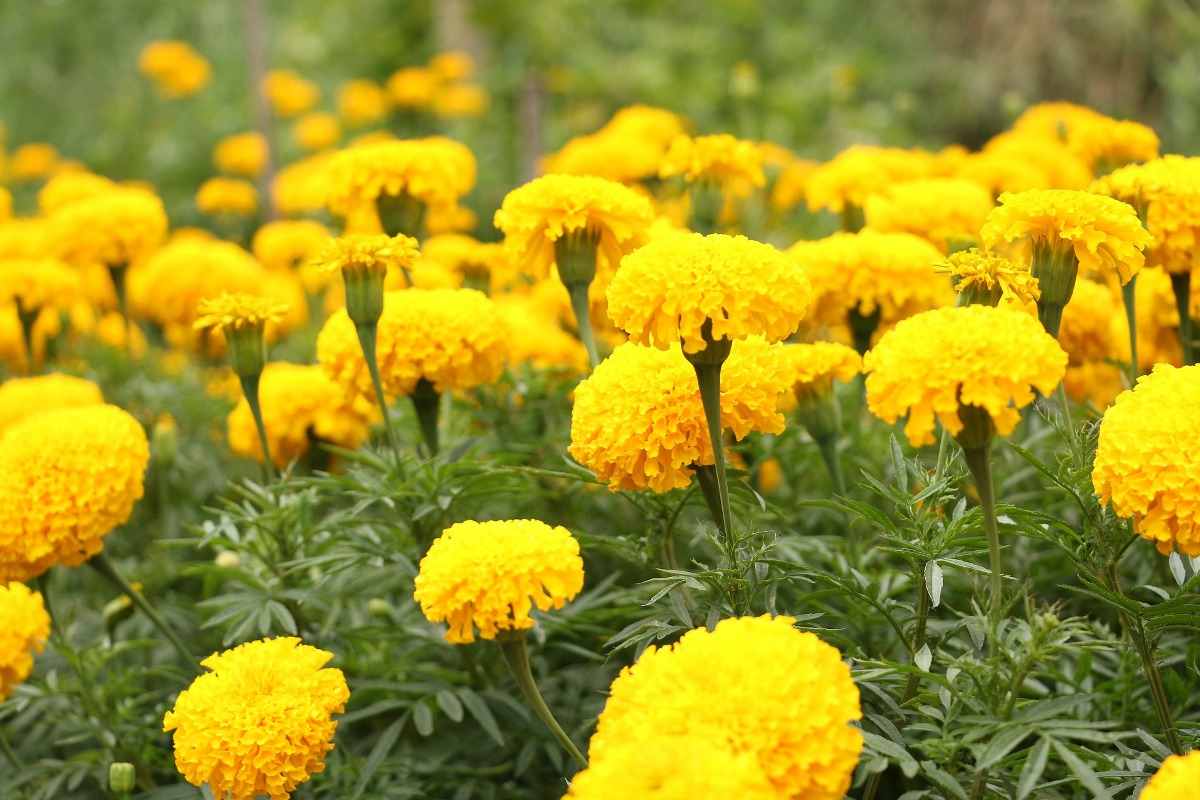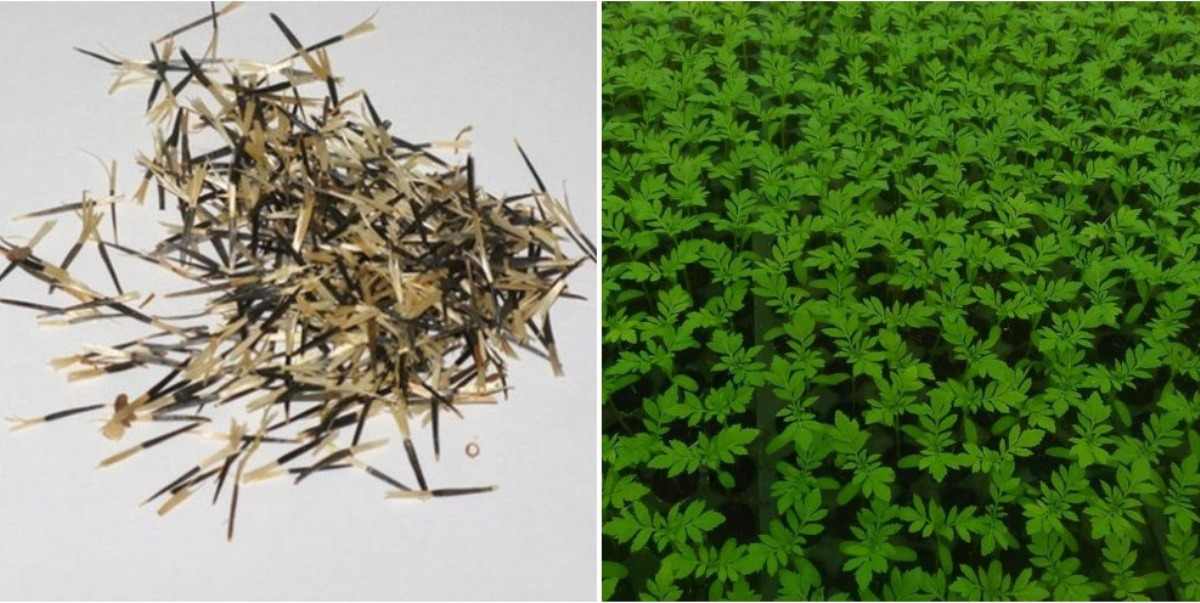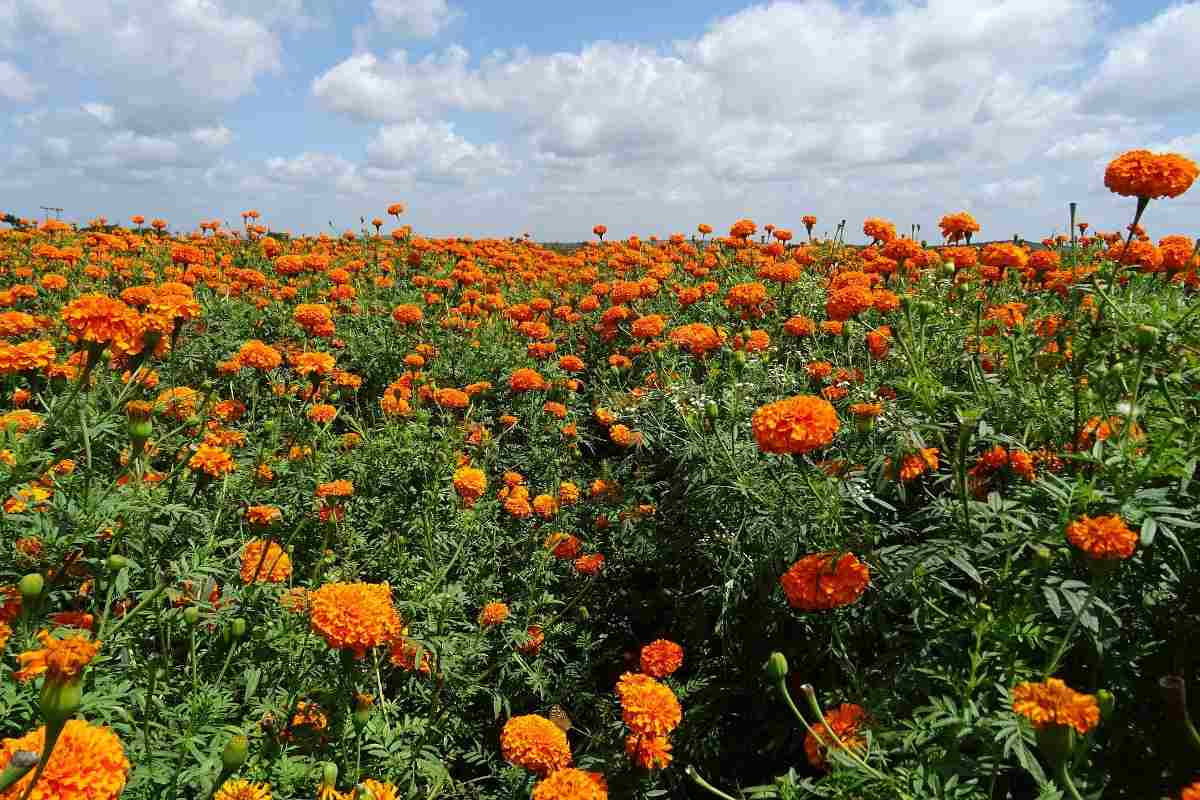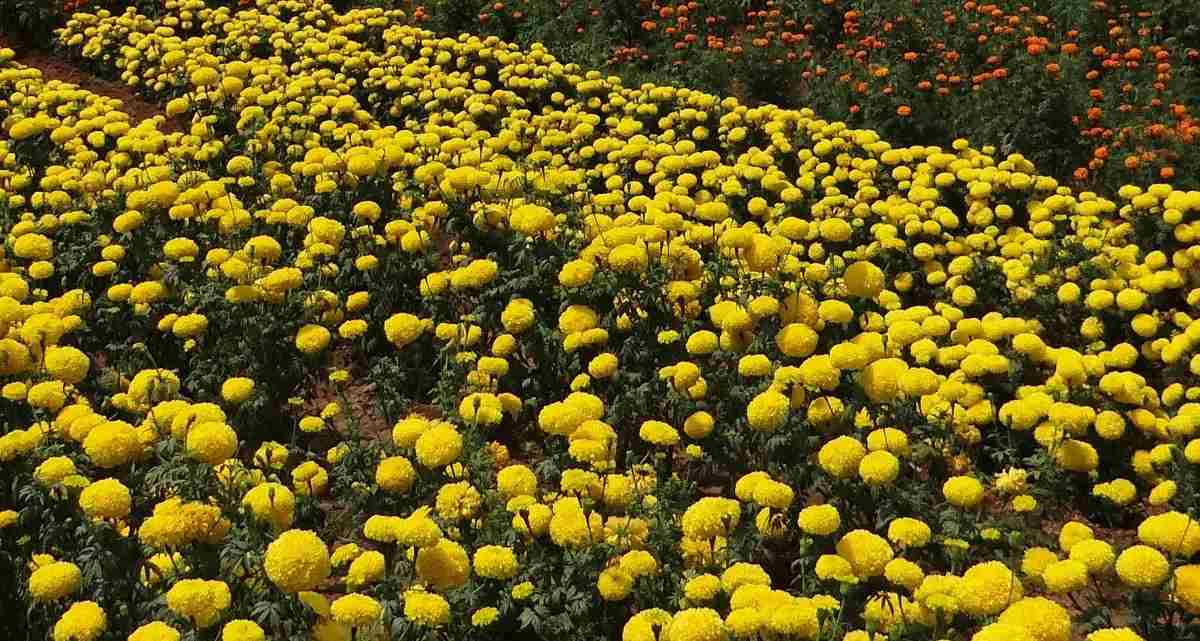Introduction: Hello friends today we will help you with Marigold seed germination, seed rate, planting methods for commercial farming. Marigold flower is one of the most generally grown flowers for garden decoration and extensively used as loose flowers for making garlands for religious and other social functions. It has gained popularity on account of its simple culture and wide adaptability, wide attractive colors, shape, size, and good keeping quality. In India, marigold is one of the most commonly grown flowers and used extensively on religious and social functions in several forms. What are we waiting for? Let’s into the details of Marigold seed germination process, time, seed rate and yield.
A guide to Marigold seed germination, seed rate, planting
Marigolds are ideal for cut flowers, particularly for making garlands. They can be planted in the beds for mass display or grown in pots or containers. The French Marigolds are appropriate for a hanging basket and edging. The demand for Marigold flowers during Dashara and Diwali is high.
Marigold flowers are attractive in shape and color. Marigold is widely adopted because of the ease of cultivation. Maharashtra, Karnataka, Gujarat, AP, Tamil Nadu, and MP are major Marigold cultivated states in India.
Some of the varieties of Marigold plants are Arka Bangara-1, Arka Bangara-2, Arka Agni, Pusa Narangi Gainda, Pusa Basanti, and Gainda.
You should not miss the Drumstick Farming Project Report.

Species of Marigold
There are two species of marigold;
Tagetes erecta (African marigold)
The African marigold plant is hardy, annual and grows 90 cm tall, erect and branched. Plant leaves are pinnately divided and leaflets are lanceolate and serrated. Flowers are single to fully double with large globular heads and the florets are either 2-lipped or quilled. Flower color changes from lemon yellow to yellow, golden yellow or orange.
Tagetes patula (French marigold)
The French marigold plant is a hardy annual grows to about 30 cm tall, forming a bushy plant. Foliage is the dark green color with the reddish stem. Plant leaves are pinnately divided and leaflets are linear, lanceolate and serrated. These flowers are small, either single or double borne on proportionately long peduncles. The flower color changes from yellow to mahogany red.
Marigold cultivation in polyhouse
Polyhouse is a very excellent example of modern agriculture. With the help of polyhouse, we can produce export quality and high quantity products so that we can get a good amount of money. Complete Protection from Pest and Insects by using polyhouse. In the polyhouse, the requirement of Labor is very less. Water and Fertilizer requirement is also less and you can get superior quality yield.
Soil requirement for Marigold cultivation
Marigold plants can be grown in a wide range of soils except for waterlogged conditions. However, a deep fertile soil having excellent water holding capacity, well-drained, sandy loam soil rich in organic matter is best suitable. Neither too acidic not too alkaline soil with a pH level of 6.0 to 7.5 is suitable.
French (Dwarf) marigolds are best cultivated in light soil whereas rich well-drained, moist soils are best suited for African (Tall) marigolds.
Climate requirement for Marigold cultivation in polyhouse
Marigold plant requires a mild climate for luxuriant growth and flowering. The optimum temperature range for its profuse growth is 18 to 20°C. Temperatures above 35°C restrict the growth of the marigold plants, which leads to a reduction in flower size and number. In severe winter, plants are damaged by frost.
Selection of site
A sunny location is ideal for marigold cultivation in polyhouse. Under the shade, it produces more vegetative growth and does not generate any flowers.
You may also consider Rose Farming Income, Cost, Profit, Project Report.
How to propage marigold
There are two common methods of propagation of marigold are by seeds and by cuttings. Marigold plants raised from seeds are tall, vigorous and heavy yielder and hence, seed propagation is preferred to cuttings.
Seed production in marigold
The seed is the best propagating material for annual flowers like marigold. However, due to the lack of scientific information on the seed production of marigold, the large scale production of seed is limited. Though the seed yield and quality are mainly a genotypic character, it is greatly influenced by the seasons and climatic factors. These influence both vegetative and reproductive phases of the Marigold plant, ultimately leading to variation in performance.
Marigold farming by seed in polyhouse
The seed rate for Marigold varies from 2.0 to 2.5 Kg per hectare and takes about 5-7 days for germination. During the preparation of beds, 8 to 10 Kg of well-decomposed farmyard manure per 1 sq.m bed is thoroughly mixed with the soil. The width of the seedbed must not be more than 1.2 m and height should be 15 cm. Before sowing of seeds a little amount of BHC dust is applied to the seedbed to avoidant or termite infestation. During winter beds must be covered with a layer of straw to accelerate the germination process. However, the straw must be removed as soon as the seedlings are visible above the soil. Seeds germinate 5 to 7 days after sowing.
Seed rate of Marigold flowers
About 600-800 grams of seeds are required for one-acre land. When the crop is 30 to 45days old carry out pitching operation. It means the removal of the terminal portion of the Marigold plant. It helps to make plant bushy and compact, also several good quality Marigold flowers with the uniform size are obtained.

Seed Treatment of Marigold
This is required for better Marigold seed germination. Treat seed with Azospirillum@200gm mixed it in 50ml of rice gruel before sowing.
You may also like the Difference Between Manure and Fertilizer.
Seed germination process in Marigold cultivation
Marigold is propagated by seeds as it germinates simply and produces vigorous plants. The marigold seeds count about 300-350/gram. The seeds remain viable for about 1 to 2 years. The germination of fresh seeds is about 90 to 95%. The seeds germinate well at a temperature range from 18-30°C.
Begin Marigold seeds in a seed-starting flat that’s filled up until 3/4 inch from the top with sterile, moist, seed-starting mix. Sprinkle the seeds on top of the medium and sow them at a depth that equals 2 to 4 times the diameter of the seeds. Spray the soil surface with water carefully to moisten it, and then place the tray in a plastic bag or cover it with plastic wrap and this will promote soil-moisture retention.
Marigold seeds can germinate in light and darkness as long as they are exposed to a temperature of 70 degrees Fahrenheit. During the Marigold germination period, remove the plastic daily to aerate the tray and check the soil moisture. If needed, moisten the medium with a water-filled spray bottle to avoid washing away the Marigold seeds. You want the soil to remain moist, not wet, during the whole germination period.
Raising of seedlings in Nursery
Nursery beds are prepared by digging up to a depth of 30cm and the beds are properly cleaned, leveled and the soil is enriched by applying well rotten FYM. To protect the Marigold seeds from the infestation of ants, BHC powder is dusted on the raised beds. Approximately, 3kg of seeds is sufficient to plant the one-hectare area. Marigold seeds are sown thinly and are covered with light soil. The beds are then watered with fine rose water can to avoid the displacement of seeds.
Transplanting of Seedlings of Marigold
Marigold seedlings are easily established after transplanting in the field without much mortality and a fast-growing root system presents in this species enable the seedlings to establish better. At the time of transplanting, seedlings normally of about one month old should have attained 3 to 4 true leaves and must be stocky.
Closely sown seeds give rise to thin, long and weak plants that are leggy and do not create a good plant. Very old seedlings are not desirable because they have lost their juvenile phase in the nursery itself. Seedlings must be transplanted in well-prepared land in the evening particularly during rainy and summer seasons to avoid exposure to harsh weather, transplanting shock and to allow better establishment in cool hours of the night.
The soil must be pressed well around the root zone so that there are no air spaces left. After transplanting, light irrigation is necessary. Heavy irrigation if done immediately after transplanting seedlings bent down and leave stick with the soil which delays good development of the plant. On light sandy soil irrigation a day before transplanting is considered useful for the better establishment of seedlings.
Irrigation requirement for Marigold cultivation
At all stages of vegetative growth (55-60 days) and during Marigold flower production sufficient amount of moisture in the soil is essential. Moisture stress at any phase affects normal growth and flowering. In lighter soils, more frequent irrigations are necessary than in heavy soils. In sandy loam soil, weekly irrigation is essential between September to March while during summer months between April to June irrigation at 4-5 days intervals is required
Manures and Fertilizers
Incorporate 50 tonnes of Farmyard Manure (FMY) per hectare during the last plowing. Apply 400 kg N, 200 kg P2O5 and 80 kg K2O per hectare area. Half of the nitrogen, entire dose of phosphorus and potash must be applied as basal dose, preferably one week after transplanting. The rest half of Nitrogen must be given two or three times during the vegetative growth period preferably applied one month after the first application at fifteen days interval. Irrigate after every application of fertilizers.
How to control weeds in Marigold crop
In marigold cultivation, control of weeds is an important operation. In India, 3 to 4 manual weeding are required for the entire period. Chemical weed control is recommended.
You may also read the Cabbage Farming in Polyhouse.

Pests and diseases of Marigold plants
Marigold plants have few pests or problems overall, but mites and aphids sometimes infest the plants. Generally, a spray of water or the application of insecticidal soap, repeated every other day for a week or two, will solve the problem. Marigold plants can be susceptible to gray mold, bacterial leaf spot, powdery mildew, and root rot. Pests such as leaf miners or spider mites can also be a problem. Interestingly enough, Marigolds also do their fair share of repelling many types of insects.
Occasionally marigold plants will get a fungal infection if conditions are too wet. To prevent fungal issues, avoid getting water on the marigold plant leaves, keep weeds down, and plant in well-drained soil.
How and When to harvest Marigold flowers
Depending upon variety use, the marigold will be ready to harvest in 2 to 2.5 months. French marigold ready for harvesting in 1.5 months whereas 2 months required for African marigold. Plucked marigold plants when they attain full size. Harvesting must be done either in the morning or evening hours. The field must be irrigated before the plucking of flowers; it will help to maintain quality for a longer period.
Loose flowers are plucked when attaining full size depending upon the plant variety. Flowers must be harvested in the morning hours. Irrigation before plucking gives better Marigold flower quality. Plucking of Marigold flowers regularly and removal of dried flowers enhance the yield. For Garland stalkless fully opened flowers or loose flowers are picked, white for vase decoration also fully opened flowers with stalk are plucked. Loose Marigold flowers are packed in a bamboo basket, while flowers with stalk are bunched in bundles and transported to the market.
Packing
After harvesting, it is better to keep Marigold flowers in a cool place. The marigold is packed in gunny bags for the local market and distance market bamboo basket is used.
Marigold flower production per acre in India
The yield of Marigold flowers varies with type and variety. Normally, marigold flower production per acre in India will be 4 to 6 tonnes of flowers per acre can be obtained. However, Giant African yellow when planted in September can give 10 tonnes of flowers per acre.
The average yield of Marigold
From one Marigold plant, about 100 to 150 flowers are obtained. The yield of flowers in African marigold and French marigold does not vary with cultivar but also cultural practices including planting, spacing, irrigation, and fertilization. The average yield of Marigold is about 18 tonne/ha.
You can get into Cucumber Farming in Polyhouse.

Cost of Marigold flowers
The cost of Marigold flowers per kg will be approximately Rs 60 to 100/Kilogram. It all depends on season, quality and variety of Marigolds.
Economic importance of Marigolds in India
- Marigold is one of the important commercially grown loose flower crops in India. It is used as a loose flower or to make garlands, which are widely used in religious and social functions.
- Marigold cultivation in India is profitable farming with low investment and minimal care. Marigold is an important ornamental crop normally return from the unit area.
- The recommended marigold cultivation practices are complex and cost involving which need sufficient information on the part of farmers. In the garden, the marigold plant provides beautification of beds and borders.
- Extensively used for making garland, beautification and other general purposes like pigment and oil extraction.
- Widely grown in gardens and also pots.
- These are highly suitable for herbaceous border and bedding plants.
- Commercially grown for the extraction of carotene pigments mostly xanthophylls added to poultry feed for intensification or yellow color of egg yolk.
- Marigold plantation as intercrop reduces the population of nematode and this flower is used for making garlands. Natural Marigold is used for many purposes like functions, ceremonies, beauty care products, decoration, fashion articles, etc.
That’s all folks about seed germination of marigold, avarage seed rate, and planting from seed. Keep growing flowers!.
You may be interested in Potting Soil Mix for Flowers.
Useful information. Thanks for sharing.
Marigold seeds price?
Where to buy?